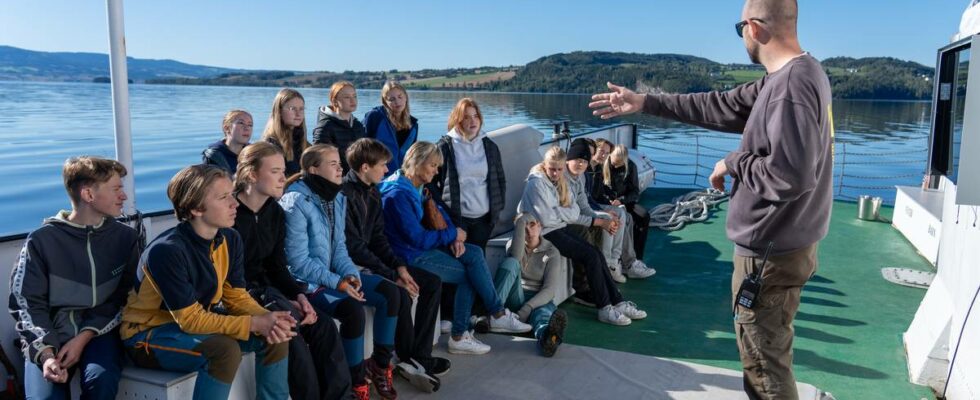The case in summary: Over the next two years, 3,500 pupils from seven municipalities around Mjøsa will participate in a project to raise awareness of environmental problems in the lake. They learn to use underwater drones and microscopes to examine water samples. The project is called “Oppdrag Mjøsa” and is financed by Sparebankstiftelsen DNB and Hedmark Sparebankstiftelse, which have given over NOK 6 million. The project will last until 2027 and is organized by the Innlandet Science Center and the Mjøsmuseet in collaboration with the Mjøssamlingene and Atlungstad Brenneri. The summary is made by an AI service from OpenAI. The content is quality assured by news’s journalists before publication – We have a small dream that they will be the ones who might solve that challenge for us. That’s what educator Torbjørn Våga from the Innlandet Science Center says to the students in the 9th grade from Løten Ungdomsskole. Drifting on Mjøsa, on an over 100-year-old car ferry, they have one goal in mind: to learn about the environmental challenges that threaten the lake. Anton Aarnes Nilssen and Maja Limoseth Thoresen are among the students who participated in the project. Photo: Knut Røsrud / news – I’m not that “into” the environment, actually. I’m not that excited, says one of the students, Anton Aarnes Nilssen. – But I try as best I can to change a little in the weekday – after this, he says. Bathing restrictions in Mjøsa With underwater drones, students can see what is hidden in the drinking water source of over 100,000 people. There is not only blue-green algae, which put a damper on the swimming season this year, but also everything from dumped ammunition to environmental toxins. Underwater drones are used to investigate pollution in the lake. Photo: Knut Røsrud / news Will save Mjøsa The 9th graders are part of the project called Mission Mjøsa. The purpose of the project is to learn about sustainability and take care of the environmental values in the largest lake in Norway. Over the next two years, 3,500 pupils from seven municipalities around Mjøsa will participate. The intention is that young people who grow up along Mjøsa should understand what is happening to the lake. The students use a microscope to examine water samples. Photo: Knut Røsrud / news – Dramatic for Mjøsa – They must understand that something relatively dramatic is happening with Mjøsa. We want to create a commitment to do something about it, says director Arne Julsrud Berg of the Mjøsmuseet, which is helping to organize the trip, together with the Science Center and NTNU. – In the 1970s, the Housewives Association in Gjøvik got involved in the Mjøsaksjonen. We need it again. We need environmental activists who want to do something. Educator Elisabeth Bjerke Råstad from the Science Center Innlandet says that the pupils do everything themselves. – They take samples of water and plankton, and use their bodies and heads in a different way than in a classroom, she says. – This is more fun than going to school anyway. It’s fun to get out a bit, says Anton Aarnes Nilssen. Mjøsaksjonen An environmental action that took place in the period 1973–1982 to reduce pollution in Mjøsa. Should ensure a safe and sustainable supply of drinking water to the surrounding area. The most important measures were to build municipal sewage treatment plants, replace older and dilapidated sewage pipe systems, ban phosphate-containing chemicals, prevent direct emissions from the processing and food industry and prevent manure runoff from agriculture. The state contributed NOK 60 million to the construction of treatment plants, in what was later called “the poor Mjøsaksjonen” (1973-1977). In what was later called “the great Mjøsaksjonen” (1977-1982), around NOK 1.4 billion was spent on various measures aimed at pollution from residential areas. Source: Wikipedia Falling commitment to the environment and climate Several surveys show that young people are less committed to climate now than before. Among other things, Nature and Youth’s membership has halved in the last five years. Arne Julsrud Berg in the Mjøsmuseet is not afraid that the pupils will get tired of the “buzz” about the environment and climate. He says that through this project they get a practical approach, where sensory impressions are put to use. – Then it is easier to understand why this is important. Costly project The largest contributors to the project are Sparebankstiftelsen DNB and Hedmark Sparebankstiftelse, which have given over NOK 6 million. Those behind it are the Science Center Innlandet and the Mjøsmuseet in collaboration with the Mjøsamlingene and Atlungstad Brenneri. The project will last until 2027. A total of 3,500 pupils will participate in the project over a period of over three years. Photo: Knut Røsrud / news Published 17.09.2024, at 16.49
ttn-69
Assignment Mjøsa will create environmental commitment among young people while fewer young people are involved in the environment – news Innlandet – Local news, TV and radio

